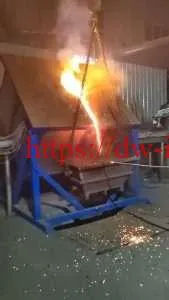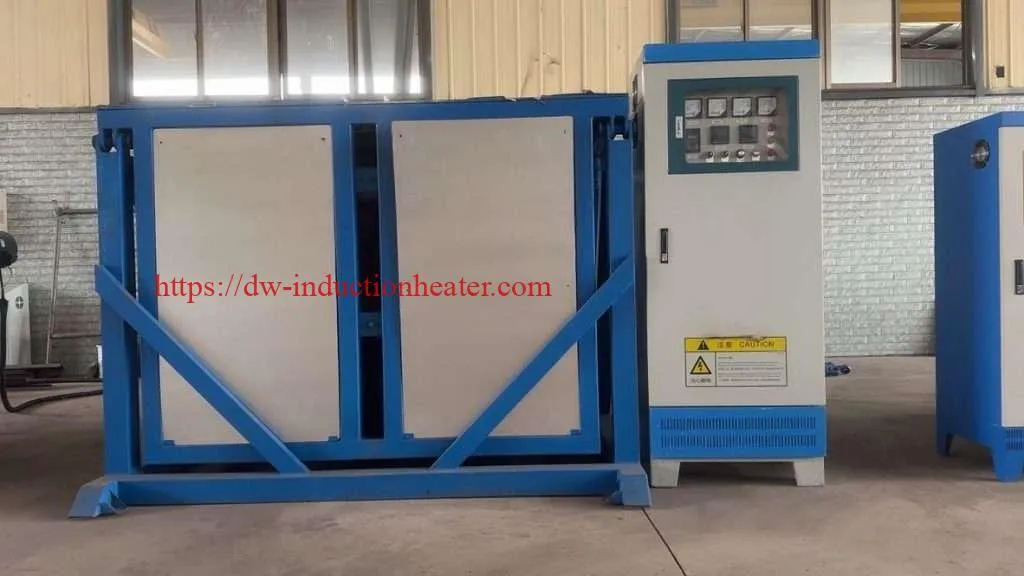Case Study: Induction Aluminum Melting Process
Objective
To efficiently melt aluminum scraps and cans using induction heating technology, achieving optimal energy efficiency while maintaining high-quality molten aluminum at the required temperature for casting operations.
Equipment
- Induction Heating Generator: 160 kW capacity
- Crucible Capacity: 500 kg aluminum melting furnace
- Furnace Type: Hydraulic tilting induction furnace
- Cooling System: Closed water tower cooling circuit
- Material Handling: Overhead crane (2-ton capacity)
- Safety Equipment: Temperature monitoring devices, emergency shutdown system, personal protective equipment
- Filtration System: Ceramic foam filters for molten aluminum purification
- Exhaust System: Fume extraction hood with filtration

Controlling System
The process is managed by a PLC (Programmable Logic Controller) system featuring:
- Allen-Bradley CompactLogix controller
- HMI touchscreen interface with graphical representation of process parameters
- Real-time monitoring of:
- Power input (kW)
- Coil current (A)
- Frequency (kHz)
- Water cooling temperature (inlet/outlet)
- Metal temperature via thermocouple
- Data logging capabilities for process optimization
- Alarm systems for abnormal operating conditions
- Multiple operating modes (manual, semi-automatic, automatic)
- Recipe storage for different aluminum alloy types
Induction Coil
- Design: Custom-designed multiple turn helical coil
- Construction: Water-cooled copper tubing (25mm diameter)
- Turns: 12 turns with optimized spacing for uniform heating
- Insulation: High-temperature ceramic fiber insulation (rated to 1200°C)
- Coil Protection: Anti-splash ceramic coating
- Electrical Connections: Silver-plated copper bus bars
- Cooling System: Dedicated water circuit with flow monitors (minimum flow rate: 45 L/min)
Frequency
- Operating frequency: 8 kHz
- Selected for optimal penetration depth in aluminum (approximately 3.5 mm)
- Frequency stability maintained within ±0.2 kHz during operation
- Automatic frequency adjustment based on load conditions
Material
- Crucible: High-density iso-statically pressed graphite crucible
- Wall thickness: 50 mm
- Service life: approximately 100 melting cycles
- Thermal conductivity: 120 W/(m·K)
- Charge Materials:
- Aluminum extrusion scrap (70%)
- Used aluminum beverage cans (20%)
- Aluminum machine turnings (10%)
- Average material size: 50-200 mm
Temperature
- Target melting temperature: 720°C (±10°C)
- Initial charge temperature: 25°C (ambient)
- Heating rate: approximately 10°C/minute
- Temperature verification: Immersion thermocouple (K-type) with digital readout
- Superheat maintained for 20 minutes before pouring
- Maximum temperature limit: 760°C (to prevent excessive oxidation)
Energy Consumption
- Average energy consumption: 378 kWh/ton
- Power factor: 0.92 (with power factor correction)
- Specific energy breakdown:
- Theoretical energy required for aluminum melting: 320 kWh/ton
- Heat losses: 58 kWh/ton
- System efficiency: 84.7%
Process
| Process Stage | Time (min) | Power Input (kW) | Temperature (°C) | Observations |
|---|---|---|---|---|
| Initial charge | 0 | 0 | 25 | 500 kg aluminum scrap loaded |
| Preheating | 0-15 | 80 | 25-200 | Gradual power increase to remove moisture |
| Heating phase 1 | 15-35 | 140 | 200-550 | Material begins to collapse |
| Heating phase 2 | 35-55 | 160 | 550-720 | Complete melting occurs |
| Temperature holding | 55-75 | 40 | 720 | Maintaining target temperature |
| Flux addition | 60 | 40 | 720 | 0.5% flux added to remove impurities |
| Degassing | 65 | 40 | 720 | Nitrogen gas purging for 5 minutes |
| Sampling & analysis | 70 | 40 | 720 | Chemical composition verification |
| Pouring | 75-85 | 0 | 720-700 | Controlled pouring into molds |
| Furnace cleaning | 85-100 | 0 | – | Dross removal, crucible inspection |
Narrative
The aluminum melting operation at XYZ Foundry demonstrates the effectiveness of induction melting for recycling aluminum scraps and cans. The process begins with careful sorting and preparation of the charge materials to remove contaminants like paints, coatings, and foreign materials that could affect melt quality.
During a typical melting cycle, the 500 kg charge is loaded into the graphite crucible positioned within the induction coil. The PLC system initiates a programmed power ramp-up sequence to prevent thermal shock to the crucible. As power increases, the electromagnetic field induces eddy currents in the aluminum, generating heat from within the metal itself.
The initial preheating phase is critical for removing moisture and volatile substances. As the temperature approaches 660°C (aluminum’s melting point), the material begins to collapse and form a molten pool. The operator monitors the process through the HMI interface, making adjustments as needed based on real-time data.
Notably, the data analysis reveals that the most energy-efficient operation occurs during the main heating phase, where the power utilization reaches maximum efficiency. The energy consumption of 378 kWh/ton represents a 15% improvement over the facility’s previous gas-fired melting furnaces.
Temperature uniformity across the melt is excellent due to the natural stirring effect created by the electromagnetic field. This eliminates the need for mechanical stirring and reduces oxide formation. The closed-loop cooling system maintains optimal operating temperatures for the induction coil and electrical components, recovering waste heat for preheating incoming materials.
After reaching the target temperature of 720°C, flux is added to facilitate the removal of non-metallic inclusions. Nitrogen gas purging through a graphite lance reduces hydrogen content, minimizing potential porosity in the final castings. Before pouring, samples are taken to verify chemical composition and make any necessary adjustments.
The hydraulic tilting mechanism allows for precise pouring control, reducing turbulence and oxide formation during the casting process. The entire operation is completed within 100 minutes from cold start to finished pour, representing a significant time savings compared to traditional methods.
Results/Benefits
| Parameter | Previous Gas-Fired System | Induction System | Improvement |
|---|---|---|---|
| Energy Consumption (kWh/ton) | 445 | 378 | 15% reduction |
| Melting Time (min/500kg) | 140 | 100 | 29% reduction |
| Metal Loss (%) | 5.2 | 2.8 | 46% reduction |
| Temperature Uniformity (±°C) | ±25 | ±10 | 60% improvement |
| CO₂ Emissions (kg/ton Al) | 142 | 64* | 55% reduction |
| Labor Hours (hrs/ton) | 1.8 | 0.9 | 50% reduction |
| Annual Maintenance Cost ($) | $32,500 | $18,700 | 42% reduction |
| Production Capacity (tons/day) | 4.2 | 6.0 | 43% increase |
| Product Quality (defect rate %) | 3.5 | 1.2 | 66% reduction |
| Workplace Temperature (°C) | 38 | 30 | 21% improvement |
*Based on local electricity generation mix
The implementation of the induction melting system has delivered significant operational, environmental, and economic benefits. The precise temperature control and reduced melting time have contributed to higher quality castings with fewer defects. Energy efficiency improvements have reduced both operating costs and environmental impact. Additionally, the improved working conditions and reduced labor requirements have positively impacted workforce satisfaction and productivity.

